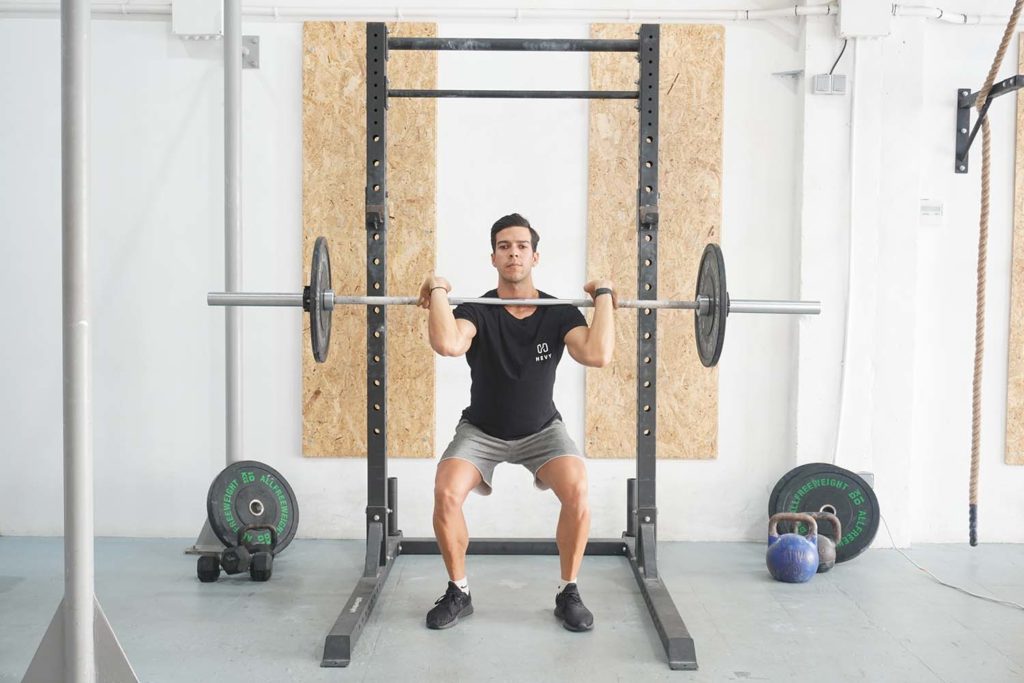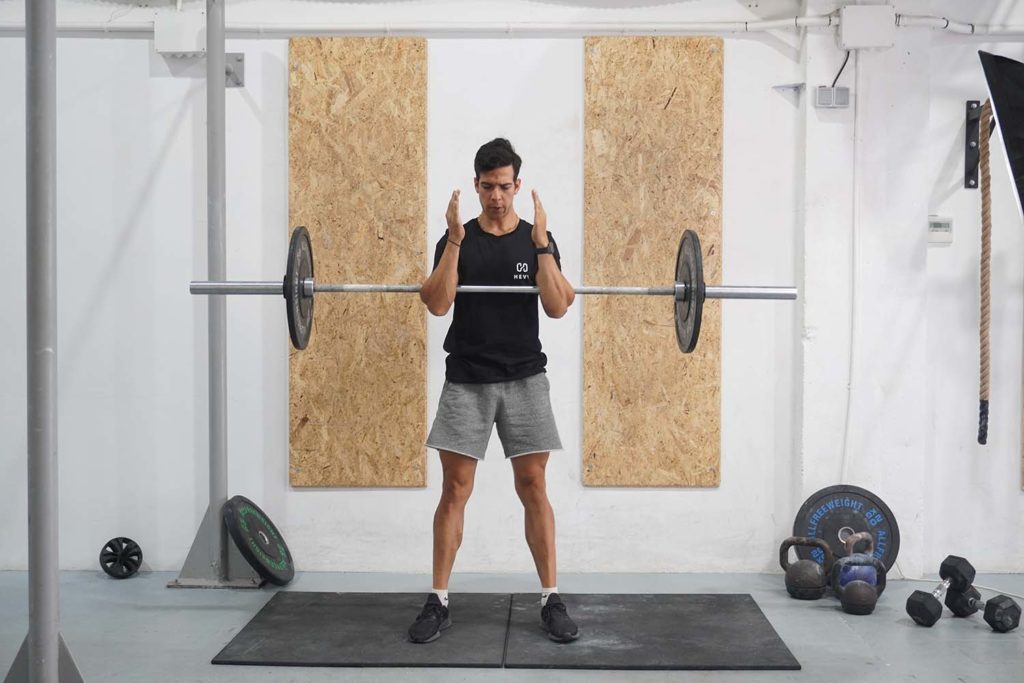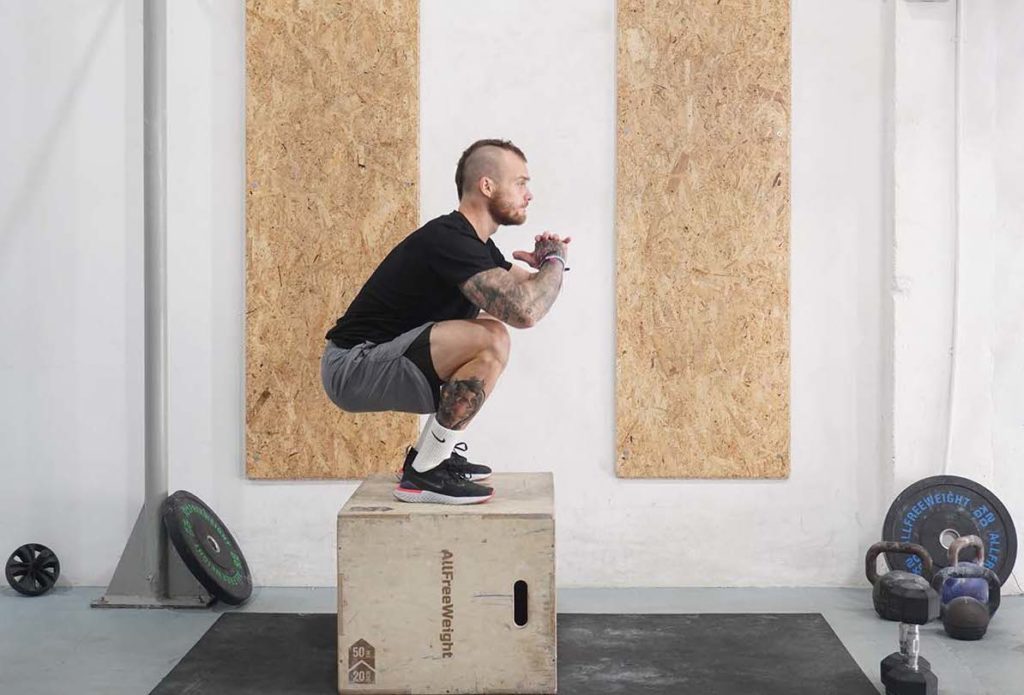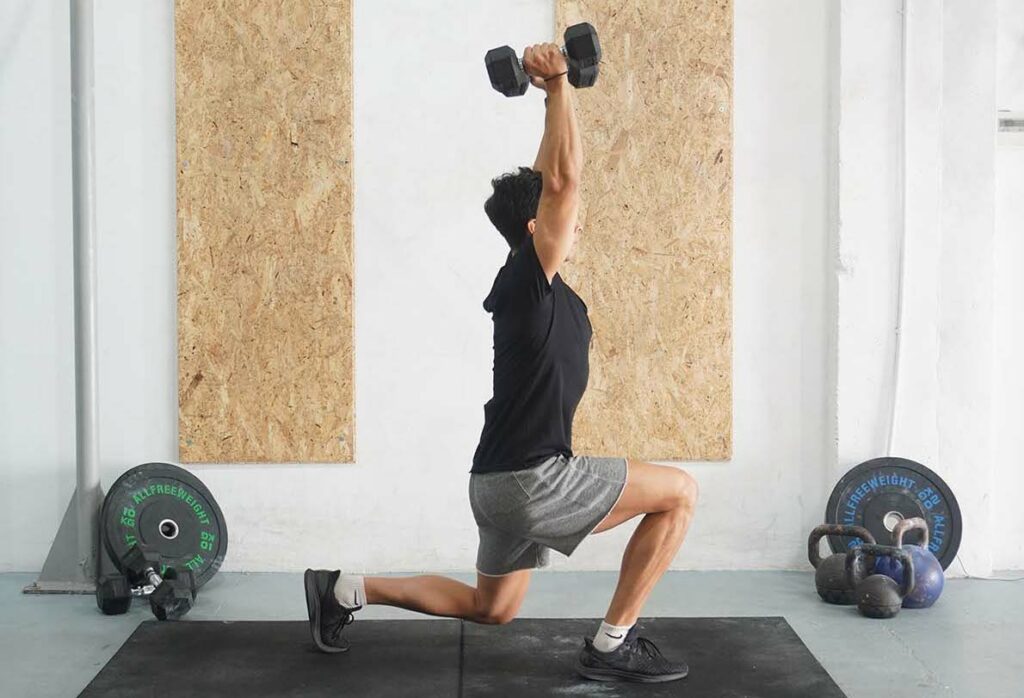The Benefits of the Overhead Squat
Overhead squats are one of the most beneficial but overlooked exercises you can perform for whole-body strength, balance, and muscle growth. As its name suggests, the objective is to lift a barbell overhead and perform squats. While seemingly simple, the movement pattern offers numerous advantages.
A notable benefit of overhead squats is that it challenges you to remain more upright during each set. Doing so forces more significant core, back, and quadriceps activation. Being more upright means you cannot rely on hip extension as much. Instead, your quadriceps must work extra hard to produce knee extension, allowing you to complete each repetition. Similarly, your back and core get stronger and grow more effectively.
Another benefit of overhead squats is that the exercise improves your squat pattern and prevents your hips from shooting up during other movements, such as the barbell back squat. As a result, squats become more effective and train the correct muscles.
The third significant advantage of overhead squats is that you get to strengthen your shoulders and triceps while working your lower body. Keeping a barbell in an overhead position requires significant shoulder and triceps involvement, leading to growth and strength gain.
Plus, the overhead squat serves as a fantastic exercise for anyone interested in Olympic weightlifting. In addition, the activity teaches important movement patterns involved in the snatch and clean and jerk.
As a whole, overhead squats are a fantastic full-body exercise that develops strength, muscle mass, and overall athleticism. You become stronger, more stable and athletic, and better able to handle everyday tasks.
We recommend including overhead squats early in your training. The movement is highly technical, so it’s best to perform it while you’re at your strongest. Fatigue in the primary muscles can worsen your technique and impair performance.
Level of Exercise: Intermediate
How to do an Overhead Squat

- Place an empty barbell on a squat stand at collarbone height.
- Stand in front of the bar and grab it with a double overhand grip. Keep your hands well apart from one another, but not to the point where you experience shoulder discomfort.
- Tuck your head underneath while keeping your hands on the bar, placing your upper back against the barbell. Keep your feet together with your knees bent slightly.
- Engage your abs, take a breath, and extend your knees to unrack the barbell from the stand.
- Take a couple of careful steps back to clear some room for the exercise.
- Take another breath, dip slightly by bending your knees, and push-press the barbell into an overhead position. Using an empty barbell is crucial for getting used to the proper setup.
- Once in an overhead squat position, take another breath, brace your core, and descend.
- Bend your knees slightly, keeping your heels in contact with the floor. Avoid hyperextending your back. Instead, keep your abs engaged and aim for a neutral spine position.
- Descend until your thighs are parallel to the floor.
- Hold the bottom position for a moment: heels in contact with the floor, knees pointing slightly out, back neutral, chest out, gaze forward, and elbows extended.
- Press through your heels to drive up as you maintain a rigid body position.
- Extend your knees and hips fully, exhaling near the top and keeping the barbell directly overhead.
- Take another breath and repeat.
What muscles does the overhead squat activate?
The primary muscle group that works during overhead squats is the quadriceps, which make up the front of our thighs and produce knee extensions (straightening of the legs) (1, 2). As mentioned above, overhead squats keep us more upright as we move up and down. Therefore, we cannot rely on hip extension, leading to better quadriceps activation.
Our hamstrings and glutes also contribute during overhead squats, but to a much lesser degree. These muscles primarily work to keep us stable during the exercise. For instance, the hamstrings contribute to knee stability, whereas our glutes support our pelvis and keep it in a neutral position.
The entire midsection musculature also contributes to overhead squats. Similar to the posterior muscles, the abs, obliques, and other muscles in the area contract isometrically to provide torso support during the movement.
Like the midsection, our back musculature produces force to keep us balanced during the exercise. Some of the working muscles are the latissimus dorsi (lats), erector spinae, and trapezius (1).
Our shoulders (deltoids) also have an active role in the overhead squat (1). The muscle group flexes isometrically to offer stability at the shoulder joint, allowing us to support a barbell overhead as we do repetitions. In addition, our triceps work with the shoulders to provide stability and extend our elbows for the squat.
Tips on How to Perform the Overhead Squat Safely
Tip 1
Overhead squats are demanding and often challenging to learn, so starting with an empty barbell is best. Doing so will help you understand the proper setup and execution for safe and effective overhead squats.
Tip 2
Keep your back in a neutral position and avoid hyperextending it. One way to achieve a neutral spine is to flex your abs before each set. Doing so will shorten the distance between the ribcage and pelvis, creating torso rigidity and improving your balance.
Tip 3
Learn how to set up for the exercise and stick with one method. Beginners would be best off learning how to push-press the barbell into an overhead position. Begin by tucking under the bar while it is on a stand, place your upper back against the barbell, unrack it, and step back. Next, dip slightly by bending your knees, and push-press the bar. Alternatively, you can snatch the bar, but that can get difficult as you start using more weight.
Tip 4
Sitting back over your heels as you descend. People new to the exercise tend to lean forward, causing the barbell to travel in front of the body, leading to loss of balance. Sitting back allows the barbell to remain over your center of gravity and for you to maintain your stability.
Tip 5
Descend as much as possible but not to the point where you start losing your balance. Like front squats, you must maintain a relatively upright torso, so you need good mobility in your shoulders, upper back, hips, and ankles to perform the exercise safely and reach a good depth. Instead of forcing the range of motion, do what you can while doing some mobility work for the mentioned areas.
Variations and Modifications of the Overhead Squat
1. Tempo Overhead Squat
Tempo overhead squats are a variation you perform by slowing down the speed. Unlike traditional squats, where you perform repetitions with an average tempo, the objective is to descend for at least three seconds and move back up at the same speed. Doing so is beneficial for improving your balance and learning to keep the barbell over your center of gravity, which can be challenging for overhead squats.
2. Clean Grip Overhead Squat
Clean grip overhead squats are a variation where you do the exercise with a clean grip (having your hands closer together). Doing so makes the exercise more challenging because you need more upper back and shoulder mobility. Clean grip squats better engage your shoulders, triceps, and upper back musculature, leading to whole-body strength and muscle gain.
3. Pause Overhead Squat
Pause overhead squats are one of the most challenging variations of the exercise. The objective is to descend as you would during any other squat but pause at the bottom for at least three seconds. Doing so is beneficial for preventing the stretch reflex of your muscles from helping you get out of the bottom position. Like tempo squats, adding a pause forces you to clean up your technique and improve your balance.
4. Dumbbell Overhead Squat
Dumbbell overhead squats are more challenging in some ways, but the variation is well-suited for beginners. Using dumbbells leads to instability and forces both sides of your body to work independently. But dumbbells can also be lighter, and you can perform the exercise even if you don’t have the best shoulder or upper back mobility.
Mistakes to Avoid
Leaning Forward
Leaning forward is perhaps the most common error seen in people doing overhead squats for the first time. As mentioned above, overhead squats require good mobility in the shoulders, upper back, and hips. Stiffness in any area would make it challenging to perform the exercise through a full range of motion or keep the barbell over your center of gravity. Leaning forward is particularly dangerous because the barbell travels forward, and your heels lift off the floor.
The two best ways to prevent the natural forward lean are to work on your upper body mobility and use the cue of sitting back into your heels as you squat.
Knees Caving In
The second common error with overhead squats is the knees caving in. People new to the exercise often struggle with caving knees not because of poor mobility or weak muscles but simply because the practice is new and they lack the experience. But, you should still be careful with your technique and monitor your knee position, especially after doing the exercise a few times. One potential cause for caving knees is weak glutes (buttocks), making it challenging to stabilize the femur (large thigh bone), causing it to move in as you squat. The second cause typically relates to poor ankle mobility. Instead of your knee traveling over your toes, it travels in as a compensatory mechanism.
Bending Your Elbows
The third mistake with the overhead squat relates to unstable elbows. Instead of keeping the arms straight and weight balanced overhead, trainees allow their elbows to bend and extend during each repetition. Doing so leads to instability, unnecessary strain on the triceps and deltoids, and a higher risk of dropping the weight. Avoid the error by push-pressing or snatching the barbell overhead, locking out your elbows, and maintaining the position. Start with an empty barbell and only increase the resistance if you’re confident you can keep your arms straight.
Similar Exercises to the Overhead Squat
Front Squat

Front squats are one of the most effective compound exercises for strengthening the quadriceps (1, 3). Like overhead squats, you must maintain an upright torso to keep the barbell in position and prevent it from falling forward. Doing so means you cannot rely on hip extension as much, and your quads have to activate extra hard to straighten your legs as you start moving up.
Zercher Squat

Zercher squats are a lesser-known variation, but they can be effective when used correctly. Like overhead and front squats, the Zercher squat forces you to maintain a more upright torso, leading to better quadriceps activation (4). On top of that, supporting the weight over the crease of your elbows leads to greater chest, shoulders, and bicep activation, making the movement beneficial for the upper body.
Box Squat

Box squats are typically done by placing the barbell behind your head and over your upper back. You must place a plyometric box or another sturdy object behind you. The object should be tall enough so when you rest your buttocks on top, your thighs are roughly parallel to the floor. Squat slowly, transfer some weight on the elevated object by sitting, and engage your quadriceps to bring yourself to the top.
Overhead Dumbbell Lunge

Overhead dumbbell lunges are another lesser-known exercise that offers many benefits athletes reap from overhead squats. The objective is to grab a pair of dumbbells, raise them overhead with your palms neutral (facing one another), and lunge forward, alternating between left and right. Doing so strengthens your lower body musculature and engages your shoulders, triceps, upper back, and core.

